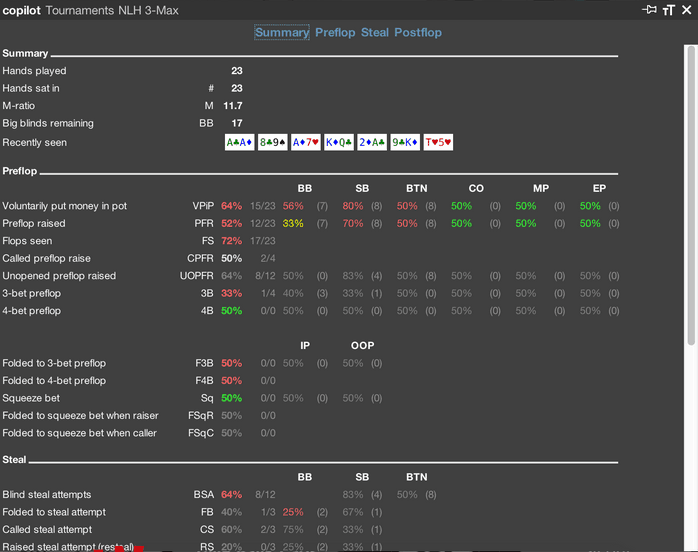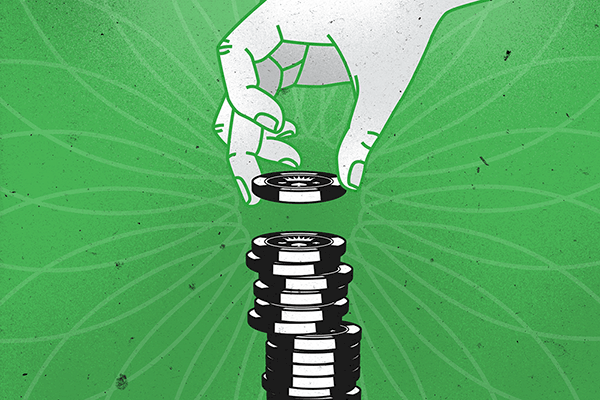Essential No Limit Holdem Strategy: The Continuation Bet
Introduction
Welcome to Poker Copilot’s Essential Strategy series, where we take a look at tactics, techniques, and concepts you’ll need to understand if you want to become a winning poker player.
Today’s post is about the continuation bet (also referred to as the c-bet).
A c-bet is the first post-flop bet made by a player who was also the first to show aggression pre-flop. It is regarded as a “continuation” of aggression, hence the name.
Players who c-bet are taking the initiative both pre-flop and post-flop.
In this piece, we take a look at the reasoning behind the c-bet. We also look at the ideal spots in which to fire one off and when to hold back.
Why Make a Continuation Bet
The logic behind the c-bet is twofold.
- You have hit the flop. In these cases, you make a c-bet because you want to get maximum value from a strong hand.
- You have not hit the flop. In these cases, the reasoning is that continued aggression is likely to be interpreted as strength and you want to get your passive opponent(s) to fold.
For the sake of this article, we won’t over-discuss the first reason. Betting when you’ve hit the flop is in most cases the right thing to do, and the purpose of this article is not to explore the strategy behind playing passively.
We’re going to explore the considerations that a good player will need to make when deciding whether to continue showing aggression despite not being obviously ahead after the flop.
Continuation Bet Sizing
A good c-bet is 2/3 or 3/4 of the pot.
You want to be consistent with your c-bets, even when you haven’t hit the flop. A common mistake that new players make is to bet a smaller amount that takes into consideration the risk they think they are taking with the bluff. They regard the bet as a greater risk and would prefer not to lose a large bet, so they only fire off a 1/2 or 1/3 pot c-bet, clearly advertising that they do not have confidence in what they are holding.
Any decent player is going to take advantage of this leak and will at some point test you with a check-raise. Folding in this scenario will be disastrous for your image at the table. And in today’s online poker landscape, especially at the upper end of micro stakes level and above, that’s going to be the majority of the players at your table.
When to C-bet
Now we get to the crux of the article – what you should bear in mind before deciding to fire off that continuation bet.
These considerations obviously never occur in a vacuum and it’s likely that you’ll always find yourself in a spot where you have to think about more than one of them at a time. This is not meant to be a definitive guide to what you should and shouldn’t do, but rather a basis for how you should be thinking when making your decision.
As mentioned before, these scenarios are all where you are not betting for value because you’ve hit a strong hand. You are either making an outright bluff with air, or you have a marginal hand. Either way, you are betting to induce a fold.
Your Cards
Even though the default play for many players has become to make a c-bet whenever you get the opportunity, regardless of your cards, this will definitely become an exploitable leak that good players will take advantage of.
Especially if your opponents have a head-up display (HUD) like Poker Copilot installed. All HUDs have a c-bet percentage statistic and most good players will have it active by default. If this figure is close to 100%, you’re going to face a check-raise at some point.
To combat this, don’t make your c-bet decision without taking your cards into consideration, simply widening your c-bet range as you find yourself in more advantageous positions.
Conversely, only c-bet with the upper end of this range if you are in a spot that is not ideal but you still feel a c-bet is appropriate.
Your Position
There are very few scenarios where position is more helpful than when deciding to c-bet or not. The benefit of position is simple: When you act last, you act on more information than the players who acted before you.
Facing a single opponent who checked the flop to you is arguably the strongest spot to be in when deciding to c-bet or not. The chances of this player folding to further aggression from you are extremely high since they have given you two indications that they are not holding anything you need to be too concerned with. In most cases, these players will be happy to get out of the hand and let you have the pot. Consider c-betting in this situation with a very wide range of cards.
If you are not in position, it gets more complex. Of course, you are still the player who showed aggression pre-flop but since your opponent has position, their pre-flop flat call isn’t necessarily a sign of weakness.
Consider what your opponent could be calling with pre-flop before instantly c-betting out of position. What will you do if you face a raise? Having hit absolutely nothing, your only option is a fold – a move that certainly won’t be ideal for your image at the table. Also, bear in mind that you do not want to artificially inflate your c-bet percentage statistic.
Resist the temptation to take down the pot out of position. There is nothing wrong with check/folding in this spot.
The Number of Opponents
Regardless of your position, the more opponents facing your post-flop aggression, the more likely a call from one of them is. The chances of an opponent having hit a low pair or a juicy draw is much higher if three or four have seen the flop.
Furthermore, you’re also sitting with the very real possibility of one caller giving another opponent pot odds to make the call.
Essentially, the smaller the size of the call is in relation to the size of the pot, the more likely a call from an opponent becomes. That means every time there is a call, the more likely another call becomes.
This is one of your primary considerations when deciding to make a continuation bet. Think very carefully how likely it is going to be to get three or four players to fold.
Your Image
This becomes more of a concern if you are playing at a poker site like Pokerstars that has a high number of regulars playing at even the micro stake levels.
And as HUD technology is becoming increasingly popular, you must be aware of the fact that several of the players at your table are going to be keeping tabs on you. Just as you are keeping an eye on your opponents’ c-bet percentage, there are almost certainly a number of players at your table doing the same for you.
Be very aware of your c-betting during a particular session. If you’ve made three consecutive authentic and successful continuation bets, seriously consider doing a fourth if you don’t have the cards to back it up.
Conversely, if you’ve been taking it easy on the c-bets, your image is one of being quite passive post-flop. It is good play to be aware of this and widen your c-bet range slightly when you’re in this spot.
The Board
This is crucial when considering the likelihood of a call. Be aware of a draw-heavy flop. This won’t be your primary concern, but seeing 9hJhTh come down when you’re holding As5s should definitely make you tighten up on your c-bet range.
Again this consideration shouldn’t be made in isolation, with the risk this board poses increasing with the number of opponents still in the hand. Out of position, against more than one opponent, think carefully if you can take down the pot with a bluff. This is a tough spot to be in.
Reads on Your Opponents
This is where a HUD becomes even more crucial since it can be used not only to deduce your player’s preflop calling range but also shows you a very handy reflection of the percentage of times the player has folded to a c-bet.
Poker Copilot calculates a statistic called “Folded to continuation bet” (FCB) which is an indication of the number of times that a player has let a hand go when they faced a c-bet from an opponent.
A very high percentage here is typically an indicator of a player who sees plenty of flops, but plays very conservatively and is perhaps not aware of c-betting as a strategy.
If you’re up against an opponent with an FCB value between 90%-%100, you can confidently widen your continuation bet range against them, especially if they are the only player in the pot and you have position on them.
There are also several other statistics which will give you great reads on your opponents when making this decision. What you are trying to avoid is coming up against a calling station.
Here are some stats that you can use to gather this information:
- Went to Showdown (WtS) is a measure of how often the player was still in the hand when the final round of betting after the river is complete. A figure of around 35 is considered relatively high and anything above that is an indicator that this is probably not a player who’s going to be scared of your aggression.
- Voluntarily put money in pot (VPIP) measured against the pre-flop raise (PFR) percentage is a statistic that illustrates the player’s pre-flop play, but can also be used to get a general idea of how passive the player is. A VPIP over 30 is quite loose and indicative of a player who over-values certain hands. If this player also has a low PFR below 8, this is a player who doesn’t quite understand the ABCs of good poker and may not recognize your bet as an indicator of strength.
- Postflop aggression frequency (Agg) is an indicator of where the player fits on the passive/aggressive spectrum when it comes to post-flop play. A very low percentage here is an indicator of a player who is likely to play a decent hand passively. Tighten your c-bet range against a player life this.

(Source: Poker Copilot)
Conclusion
Making a continuation bet is a pretty basic poker move but it is one that is easy to get wrong.
While overdoing it is unlikely to cause you to lose massive hands, it could well get you into sticky situations that will be difficult to extract yourself from on the turn and river.
If not done correctly, it is also a leak that can very easily be exploited by the ever increasing number of decent players playing at the various poker sites nowadays.
To apply the strategy for the maximum profit and minimum risk, use a HUD to get a good read on your opponents.
See you at the tables!
